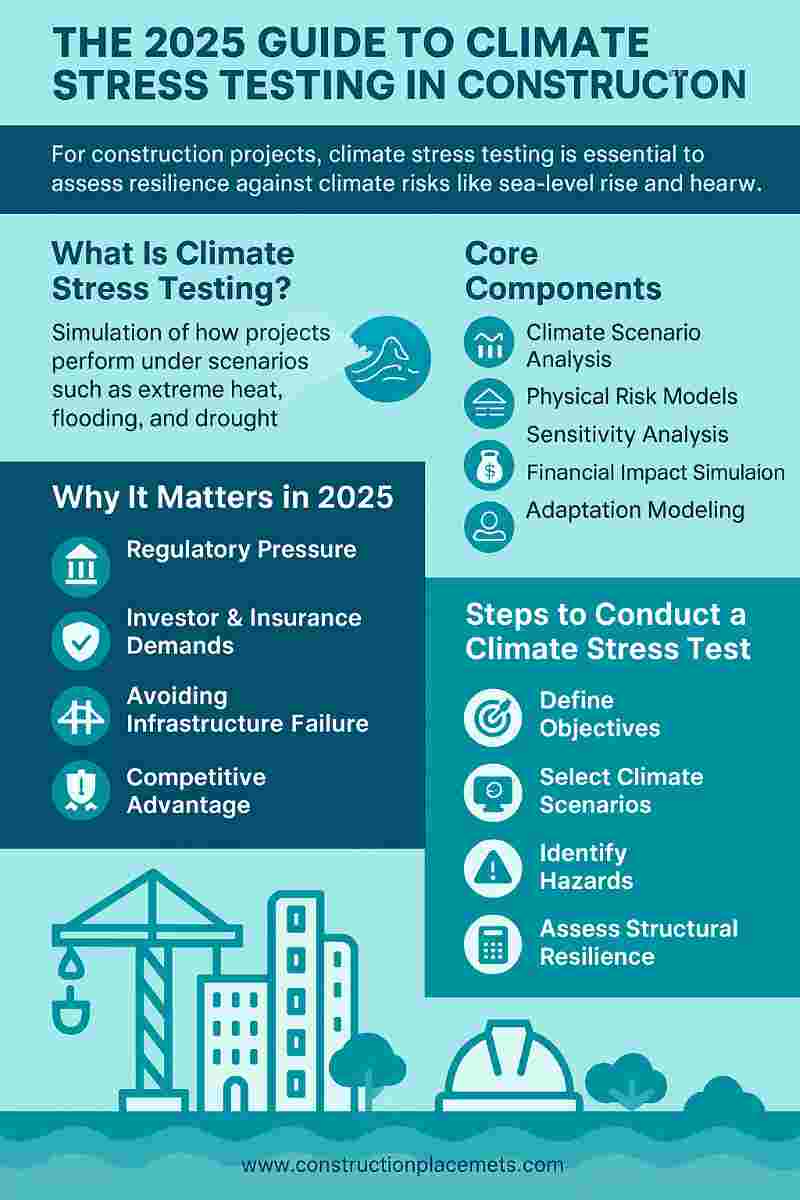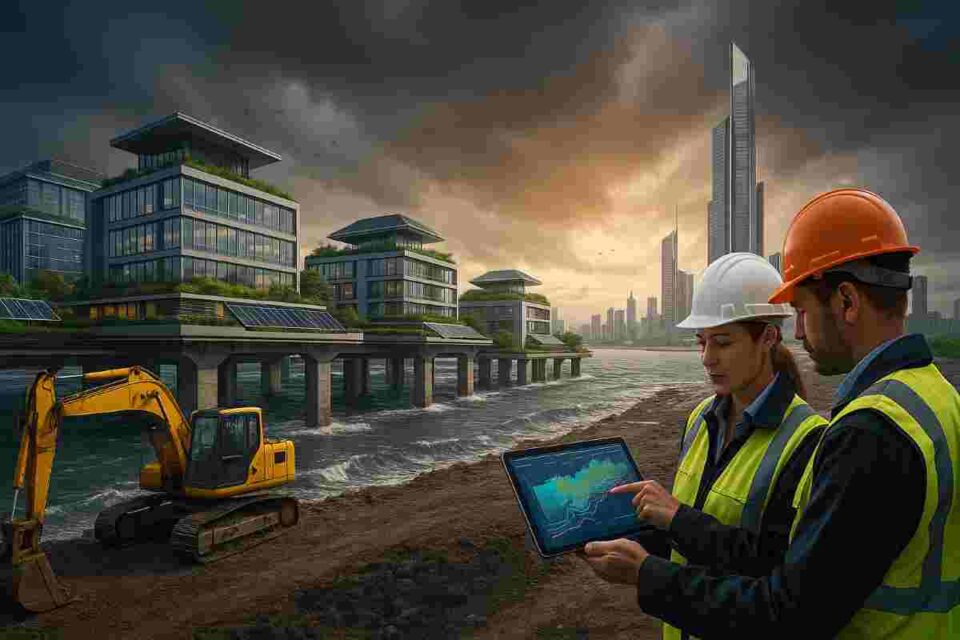Last Updated on July 3, 2025 by Admin
As climate extremes intensify, the construction industry must rethink resilience. Climate stress testing in construction has emerged as a critical strategy to safeguard buildings, infrastructure, and investments against environmental risks. From flooding and heatwaves to rising insurance demands and ESG mandates, climate risk is now central to project planning. This guide dives deep into how construction professionals can use scenario analysis, digital tools, and adaptive design to stay ahead. Whether you’re designing skyscrapers, managing portfolios, or developing cities, this is your blueprint for building with foresight in 2025 and beyond.
Table of Contents
Why Climate Stress Testing Is No Longer Optional
From rising sea levels to prolonged heat waves, climate change is no longer a distant threat—it is a present and growing challenge. For the construction industry, this shift is seismic. Buildings, bridges, roads, and entire urban developments are increasingly exposed to climate risks that threaten structural integrity and financial viability. Enter climate stress testing in construction: a powerful tool to identify, assess, and mitigate climate-related vulnerabilities.
The urgency for proactive climate risk assessments has intensified with 2025 bringing record-breaking heat events and unprecedented flooding incidents. Infrastructure failures are no longer rare occurrences—they’re becoming regular, costly, and deadly. This growing instability demands that all construction stakeholders embed climate science into their planning and execution workflows.
Practice 15+ AI-generated technical and HR interview questions for Civil, BIM, QS, Planning, HSE and Construction roles. Get instant feedback, improved answers, a 7-day improvement plan, and a full PDF report. Designed exclusively for construction professionals.
One free full interview session included. No credit card required.
Whether you’re a construction project manager, ESG analyst, sustainability consultant, or infrastructure investor, understanding and implementing climate stress testing is now essential. This guide unpacks everything you need to know—from methodology and real-world case studies to regulatory trends and digital tools—to future-proof your projects and investments.

Infographic: The 2025 Guide to Climate Stress Testing in Construction © www.constructionplacements.com
What Is Climate Stress Testing in Construction?
Definition
Climate stress testing is a structured simulation process used to evaluate how construction projects and built assets perform under various climate change scenarios. It involves testing infrastructure resilience against temperature extremes, flooding, wind, drought, and sea-level rise based on current and projected climate data.
Purpose
- Assess the vulnerability of structures
- Plan for adaptive strategies
- Align with ESG and regulatory requirements
- Protect long-term asset value
- Enhance design strategies to withstand extreme conditions
- Strengthen stakeholder confidence in construction outcomes
Core Components
- Climate Scenario Analysis: Use of Representative Concentration Pathways (RCPs) and Shared Socioeconomic Pathways (SSPs)
- Physical Risk Models: Flood maps, temperature projections, wildfire likelihood
- Sensitivity Analysis: Evaluation of structural/material limits under stress
- Financial Impact Simulation: Cost of damage, insurance implications, lifecycle costing
- Adaptation Modeling: Scenario-specific design interventions and retrofitting
Climate stress testing provides a multidimensional understanding of how buildings and infrastructure might behave over a 30–100-year horizon, offering strategic foresight for developers, municipalities, and investors.
Why Climate Stress Testing Matters in 2025
1. Regulatory Pressure Is Rising
Governments and financial institutions are tightening regulations on climate risk disclosure. Frameworks like TCFD (Task Force on Climate-related Financial Disclosures) and SFDR (Sustainable Finance Disclosure Regulation) require detailed climate risk assessments for construction and real estate portfolios. In India, the Securities and Exchange Board (SEBI) now expects ESG disclosures from listed companies, including climate resilience.
2. Investor and Insurance Demands
Infrastructure investors and insurers are embedding climate resilience into decision-making. A poorly rated building on climate risk could lead to higher premiums, financing rejections, or even insurance denial. Insurers are updating models to include chronic risks like rising temperatures and acute threats like cyclone surges.
3. Avoiding Infrastructure Failure
Real-world examples—from the Miami condo collapse to road melt in Australia and landslides in Uttarakhand—illustrate how unchecked climate risks can lead to disaster. Engineers are increasingly expected to consider compound hazards, such as heat combined with high humidity or extreme rainfall paired with poor drainage.
4. Competitive Advantage
Firms with robust climate risk frameworks are gaining preference in public tenders and ESG rankings. Construction companies that adopt stress testing gain a first-mover advantage in winning long-term, resilient infrastructure contracts, especially in coastal and urbanizing regions.
How to Conduct a Climate Stress Test in Construction
Step 1: Define Objectives
- Evaluate a single asset or portfolio?
- Compliance, risk management, or investor reporting?
- Timeline: immediate retrofitting, 30-year lifecycle planning, or long-term resilience?
Step 2: Select Climate Scenarios
Choose models based on IPCC pathways:
- RCP 2.6: Low-emission scenario
- RCP 4.5 / 6.0: Moderate scenarios
- RCP 8.5: High-emission scenario (worst case)
Ensemble modeling—aggregating multiple models—can reduce bias and increase prediction confidence.
Step 3: Hazard Identification
Use geospatial and meteorological data to map threats:
- Sea-level rise
- Flood zones (FEMA, local databases, NASA Earth Data)
- Heat stress zones
- Wildfire-prone regions
- Permafrost melt and land subsidence zones
Step 4: Structural Resilience Assessment
Apply engineering models:
- Material thermal limits
- Load-bearing changes with heat
- Drainage and waterproofing analysis
- Wind shear modeling
- Groundwater pressure simulations
- Retrofit capabilities
Step 5: Financial Risk Modeling
- Estimate damage costs per scenario
- Calculate the ROI of resilience investments
- Assess insurance premium shifts
- Lifecycle costing (30–50 years)
- Integrate shadow pricing for carbon and adaptive measures
Step 6: Adaptation and Mitigation Planning
Propose design strategies:
- Green roofs and reflective surfaces
- Elevated foundations and pile-supported structures
- Fiber-reinforced polymer materials
- Modular and mobile construction units
- Smart drainage systems
- Off-grid solar + storage microgrids
Test solutions under multiple scenarios to ensure cross-climate functionality.
Top Tools and Technologies for Stress Testing
| Tool/Platform | Functionality | Use Case |
|---|---|---|
| CLIMADA | Probabilistic impact modeling | Urban infrastructure planning |
| WeatherShift (Arup) | Local climate projections | Design adjustments |
| Moody’s ESG | Risk scoring tools | Investment decisions |
| ESRI ArcGIS | Geospatial climate visualization | Site-specific analysis |
| One Click LCA | Embodied carbon + resilience | Sustainable material choice |
| Google Earth Engine | Satellite climate data | Change detection |
| Autodesk Insight | Energy simulation | Building performance |
| Envision Platform | Sustainability scoring | Infrastructure benchmarking |
AI-augmented platforms are also emerging with real-time IoT integrations for predictive maintenance.
Real-World Applications and Case Studies
Thames Estuary 2100 (UK)
- 100-year flood plan using adjustable barriers
- 97% risk reduction
- Model for adaptive riverine planning
Miami-Dade Sea-Level Plan (USA)
- Coastal buildings stress tested for 3-ft rise
- New drainage infrastructure
- Resilience tax incentives launched
Netherlands Delta Programme (EU)
- 60B EUR invested in national flood defenses
- Zoning tied to risk scores
- Community trust built via engagement
Smart Cities Mission (India)
- Pune, Bhubaneswar stress tested for heat and flood
- Rooftop solar retrofits
- Heat-resilient public infrastructure
Who Benefits from Climate Stress Testing?
Construction Project Managers
- Manage climate-adjusted schedules
- Choose site-specific methods
Civil Engineers & Structural Designers
- Design for temperature and load extremes
- Use future-proof materials
Real Estate Developers
- De-risk investments
- Improve resale and rental value
ESG & Sustainability Consultants
- Align with TCFD, SFDR, EU Taxonomy
- Drive performance through disclosure
Infrastructure Investors
- Evaluate risk premiums
- Align portfolios with climate mandates
Key Challenges to Overcome
Data Availability
- Gaps in hyper-local climate models
- Inconsistent materials and site data
Model Uncertainty
- Forecasting assumptions may miss local variables
High Initial Costs
- Simulation and retrofitting costs can deter uptake
Limited Expertise
- Demand for cross-disciplinary knowledge is high
Climate Policy Landscape in 2025
Global
- TCFD: Climate financial disclosures
- IFRS S2: Mandatory reporting (2024)
- ISO 14090: Climate adaptation standards
- UNDRR: Global disaster resilience framework
India
- SEBI ESG Disclosure Norms
- National Infrastructure Pipeline (NIP)
- Smart Cities Framework
EU
- EU Taxonomy for sustainable activities
- SFDR compliance for investors
- Green Deal Climate Screening Tool
Future Trends in Stress Testing and Resilience
- AI-powered climate forecasting
- BIM + Digital Twins integration
- Dynamic building codes updated annually
- Insurance priced by resilience scores
- Real-time climate response through IoT
- Resilience indices for public procurement
Related Posts:
- What is ESG (Environmental, Social, and Governance)?
- Navigating Life’s Complexity: Pathways to Discovering Your True Calling
- Impact of ESG (Environmental, Social, and Governance) Laws on M&A
- Climate Risk Management and Sustainability: Redefining the Future of Business and Construction
- The Role of a Pipe Stress Engineer in Industrial Projects
FAQs: People Also Ask
Q1. What is climate stress testing in construction?
Climate stress testing is a simulation-based method used to evaluate how infrastructure projects will perform under future climate scenarios. It assesses risks like extreme heat, floods, storms, and sea-level rise to ensure resilience and long-term viability.
Q2. Why is climate stress testing important for ESG compliance?
It supports Environment, Social, and Governance (ESG) reporting by providing data-driven insights into a project’s vulnerability to climate risks. This transparency is crucial for regulatory disclosures and maintaining investor confidence.
Q3. What tools are used for climate stress testing?
Popular tools include CLIMADA (open-source impact modeling), ArcGIS Climate Resilience tools, Moody’s ESG Solutions, and UNEP FI TCFD toolkits. These help simulate scenarios, quantify risks, and map vulnerabilities across assets and geographies.
Q4. Is climate stress testing becoming mandatory?
Yes. Many regions, including the EU, UK, and parts of Asia, are integrating stress testing into mandatory sustainability disclosures for public infrastructure and large-scale developments. India and the U.S. are also aligning their ESG frameworks to include such resilience checks.
Conclusion: Build Smarter, Not Just Stronger
As the climate crisis deepens, the construction industry stands at a crossroads. Will we build as we always have, or will we embrace a future-proof approach? Climate stress testing in construction offers a clear path forward—combining engineering rigor, data science, and strategic foresight to create resilient, adaptive infrastructure.
If you’re a builder, engineer, or investor, now is the time to embed climate resilience into your planning. Not just for compliance, but for survival, savings, and sustainability.
Next Steps:
- Explore for updates on ESG trends
- Download our climate risk assessment checklist
- Share this guide with colleagues and partners
Explore More:
- Sustainable Building Materials
- Construction Risk Management
- Green Building Certifications
- Digital Construction Technology


